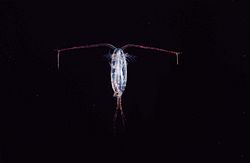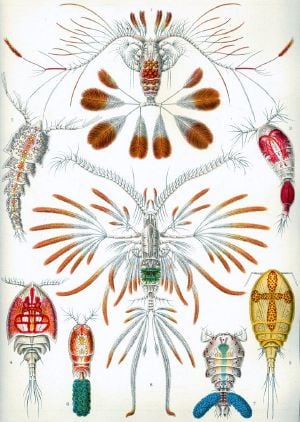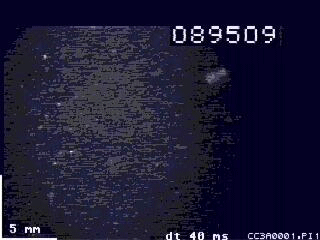Difference between revisions of "Copepod" - New World Encyclopedia
Rick Swarts (talk | contribs) |
Rick Swarts (talk | contribs) |
||
| Line 7: | Line 7: | ||
{{Taxobox_phylum_entry | taxon = [[Arthropod]]a}} | {{Taxobox_phylum_entry | taxon = [[Arthropod]]a}} | ||
{{Taxobox_subphylum_entry | taxon = [[Crustacea]]}} | {{Taxobox_subphylum_entry | taxon = [[Crustacea]]}} | ||
| − | {{Taxobox_classis_entry | taxon = [[Maxillopoda]]}} | + | {{Taxobox_classis_entry | taxon = [[Maxillopoda]]*}} |
{{Taxobox_subclassis_entry | taxon = '''Copepoda'''}}<br/>{{Taxobox authority | author = [[Henri Milne-Edwards|H. Milne-Edwards]]* | date = 1840}} | {{Taxobox_subclassis_entry | taxon = '''Copepoda'''}}<br/>{{Taxobox authority | author = [[Henri Milne-Edwards|H. Milne-Edwards]]* | date = 1840}} | ||
{{Taxobox_end_placement}} | {{Taxobox_end_placement}} | ||
{{Taxobox_section_subdivision | color = pink | plural_taxon = Orders}} | {{Taxobox_section_subdivision | color = pink | plural_taxon = Orders}} | ||
| − | + | Calanoida<br> | |
| − | + | Cyclopoida<br> | |
| − | + | Gelyelloida<br> | |
| − | + | Harpacticoida<br> | |
| − | + | Misophrioida<br> | |
| − | + | Monstrilloida<br> | |
| − | + | Mormonilloida<br> | |
| − | + | Platycopioida<br> | |
| − | + | Poecilostomatoida<br> | |
| − | + | Siphonostomatoida | |
{{Taxobox_end}} | {{Taxobox_end}} | ||
| − | '''Copepods''' are a group of | + | '''Copepods''' are a group of generally minute [[crustacean]]s found in marine waters and nearly every freshwater habitat. Crustaceans (subphylum Crustacea), the group of [[arthropod]]s (phylum Arthropoda) that includes the familiar crabs, lobsters, shrimps, barnacles, krill, and crayfish, are characterized by having branched (biramous) appendages, an exoskeleton made up of chitin and calcium, two pairs of antennae that extend in front of the mouth, and paired appendages that act like jaws. Copepods are characterized by a teardrop shaped body, large [[antennae, and, at least in the larval stage, a single, simple [[eye]], usually bright red, in the center of its transparent head. |
| − | + | Copepods are variously classified as one taxa with barnacles in the class Maxillopoda, or as a separate class Copepoda. The group contains ten [[order (biology)|order]]s with some 14,000 described [[species]]. A scientist that studies copepods is a ''copepodologist''. | |
| − | + | Copepods are generally small, about 1 to 2 millimeters (0.04 to 0.08 inches), although the parasitic ''Pennella sp.'', the largest copepod in the world, grows to nearly 0.3 meters (Bridges and Arnold 2002). Although like other crustaceans, copepods have an armored exoskeleton, they are so small that in most species this armour, and the entire body, is almost totally transparent. | |
| − | + | Many species of copepods are [[plankton]]ic, but more are [[benthos|benthic]], and some continental species may live in limno-terrestrial habitats and other wet terrestrial places, such as swamps, under leaf fall in wet forests, bogs, springs, ephemeral ponds and puddles, damp moss, or water-filled recesses (phytothelmata) of plants such as [[bromeliad]]s and [[pitcher plant]]s. Many live underground in marine and freshwater caves, [[sinkhole]]s, or stream beds. Some copepods are [[parasite|parasitic]] and attach themselves to fish, sharks, marine mammals, and many kinds of invertebrates such as molluscs, tunicates, or corals. | |
| + | copepods can be very important ecologically, as a key part of the food chain. There may be millions in a cubic meter of ocean. Being the largest biomass in the oceans, they have been called the ''insects of the sea'' (Durbaum and Kunnemann 2006). | ||
| − | |||
| − | + | ==Characteristics== | |
| − | + | Copepods are typically 1-2 mm long, with an elogated body, forked tail, and large [[antenna]]e. Some free-living polar copepods reach 1 cm. ''Pennella sp.'' is a parasitic copepod of the Fin Whale; it grows to 30cm and can appear as if a piece of fishing line or a tag, hanging from the skin (Bridges and Arnold 2002). It embeds its head in the blubber of the whale and feeds on its blood and inflamed tissue (Bridges and Arnold 2002). | |
| + | |||
| + | Most of the smaller copepods feed directly on [[plankton|phytoplankton]], catching cells singly, but a few of the larger species are predators of their smaller relatives. Herbivorous copepods, particularly those in rich cold seas, store up energy from their food as oil droplets while they feed in the spring and summer plankton blooms. These droplets may take up over half of the volume of the body in polar species. | ||
| + | |||
| − | + | Like other [[crustacean]]s, copepods have an armored exoskeleton, but they are generally so small that in most species this armor, and the entire body, is almost totally transparent. Copepods have a single eye, usually bright red and in the centre of the transparent head. | |
| − | + | ||
| − | + | [[Image:Haeckel Copepoda.jpg|thumb|left|Copepods from [[Ernst Haeckel]]'s ''Kunstformen der Natur'']] | |
| + | Many species have [[neuron]]s surrounded by [[myelin]], which is very rare among [[invertebrate]]s (other examples are some [[annelid]]s and [[malacostraca]]n crustaceans like palaemonid shrimp and penaeids). Even rarer is the fact that the myelin is highly organized, resembling the well-organized wrapping found in [[vertebrate]]s (Gnathostomata). | ||
| + | |||
| + | At least one third of the known species live as parasites on, or symbionts with, fish and invertebrates (Durbaum and Kunnemann 2006). | ||
| + | Some copepods are very evasive and can jump with extreme speed over a few millimeters. | ||
| + | [[Image:Cc3s.gif|frame|Slow-motion macrophotography video (50%) of juvenile [[Atlantic herring]] (38 mm) feeding on copepods - the fish approach from below and catch each copepod individually. In the middle of the image a copepod escapes successfully to the left.]]This scene was scanned with the [[ecoSCOPE]], an underwater high speed microscope. Very little is known about the details of these kinds of predator/prey interactions, in spite of their importance for global processes, because copepods are difficult to keep in the laboratory and lose most of their escape capacity, and herring are very fast, alert and evasive organisms and flee normal camera systems or [[Scuba diving|scuba divers]]. | ||
==Ecology== | ==Ecology== | ||
| − | + | copepods are widely distributed, with species of the Calanoida, Cyclopoida, and Harpacticoida having colonized habitats from small creeks to high Himalayan glacier lakes (Durbaum and Kunnemann 2006). Some copeopods can be found in the leaf fall of wet forests, in compost heaps, in peat moss, and even int eh little ppols forme din the leaf axils of plants (Durbaum and Kunnemann 2006). | |
| − | + | Planktonic copepods are important to global [[ecology]] and the [[carbon cycle]]. | |
| − | |||
| − | [[ | + | Copepods are usually the dominant members of the [[plankton|zooplankton]], and are major food organisms for small [[fish]], [[whale]]s, [[seabird]]s, and other [[crustacean]]s such as [[krill]] in the ocean and in fresh water. Some scientists say they form the largest animal [[biomass]] on earth. They compete for this title with Antarctic krill (''Euphausia superba''). |
| − | |||
| − | + | Because of their smaller size and relatively faster growth rates, however, and because they are more evenly distributed throughout more of the world's oceans, copepods almost certainly contribute far more to the secondary productivity of the world's oceans, and to the global ocean [[carbon sink]] than [[krill]], and perhaps than all other groups of organisms together. The surface layers of the oceans are currently believed to be the world's largest [[carbon sink]], absorbing about 2 billion tons of carbon a year, the equivalent to perhaps a third of human carbon emissions, thus reducing their impact. Many [[plankton]]ic copepods feed near the surface at night, then sink into deeper water during the day. Their moulted [[exoskeleton]]s, [[feces|faecal]] pellets and [[respiration]] at depth all bring [[carbon]] to the deep sea. | |
| − | |||
| − | + | Copepods are sometimes found in the public mains water supply, especially systems where the water is not filtered, such as [[New York City]] and [[Boston, Massachusetts]]. This is not usually a problem in treated water supplies. In some tropical countries, such as [[Peru]] and [[Bangladesh]], a correlation has been found between copepods and [[cholera]] in untreated water, because the cholera bacteria attach to the surfaces of planktonic animals. The risk of cholera from infected water can be reduced by filtering out the copepods (and other matter), for example with a [[cloth filter]]. | |
| − | Copepods | ||
| − | + | In New York City, the presence of copepods in tap water became controversial when spotted by rabbis in Brooklyn because of clashing views on whether consumption of such unfiltered water violates the biblical prohibition against eating visible waterborne creatures that lack fins and scales (Berger 2004). | |
| − | |||
| − | + | ==References== | |
| + | http://www.reef.crc.org.au/publications/brochures/minke_2002_www.pdf. | ||
| + | Bridges, Arnold article | ||
| − | |||
| − | |||
== External links == | == External links == | ||
Revision as of 01:55, 18 January 2007
| Copepod | ||||||||||
|---|---|---|---|---|---|---|---|---|---|---|
 | ||||||||||
| Scientific classification | ||||||||||
| ||||||||||
| Orders | ||||||||||
|
Calanoida |
Copepods are a group of generally minute crustaceans found in marine waters and nearly every freshwater habitat. Crustaceans (subphylum Crustacea), the group of arthropods (phylum Arthropoda) that includes the familiar crabs, lobsters, shrimps, barnacles, krill, and crayfish, are characterized by having branched (biramous) appendages, an exoskeleton made up of chitin and calcium, two pairs of antennae that extend in front of the mouth, and paired appendages that act like jaws. Copepods are characterized by a teardrop shaped body, large [[antennae, and, at least in the larval stage, a single, simple eye, usually bright red, in the center of its transparent head.
Copepods are variously classified as one taxa with barnacles in the class Maxillopoda, or as a separate class Copepoda. The group contains ten orders with some 14,000 described species. A scientist that studies copepods is a copepodologist.
Copepods are generally small, about 1 to 2 millimeters (0.04 to 0.08 inches), although the parasitic Pennella sp., the largest copepod in the world, grows to nearly 0.3 meters (Bridges and Arnold 2002). Although like other crustaceans, copepods have an armored exoskeleton, they are so small that in most species this armour, and the entire body, is almost totally transparent.
Many species of copepods are planktonic, but more are benthic, and some continental species may live in limno-terrestrial habitats and other wet terrestrial places, such as swamps, under leaf fall in wet forests, bogs, springs, ephemeral ponds and puddles, damp moss, or water-filled recesses (phytothelmata) of plants such as bromeliads and pitcher plants. Many live underground in marine and freshwater caves, sinkholes, or stream beds. Some copepods are parasitic and attach themselves to fish, sharks, marine mammals, and many kinds of invertebrates such as molluscs, tunicates, or corals.
copepods can be very important ecologically, as a key part of the food chain. There may be millions in a cubic meter of ocean. Being the largest biomass in the oceans, they have been called the insects of the sea (Durbaum and Kunnemann 2006).
Characteristics
Copepods are typically 1-2 mm long, with an elogated body, forked tail, and large antennae. Some free-living polar copepods reach 1 cm. Pennella sp. is a parasitic copepod of the Fin Whale; it grows to 30cm and can appear as if a piece of fishing line or a tag, hanging from the skin (Bridges and Arnold 2002). It embeds its head in the blubber of the whale and feeds on its blood and inflamed tissue (Bridges and Arnold 2002).
Most of the smaller copepods feed directly on phytoplankton, catching cells singly, but a few of the larger species are predators of their smaller relatives. Herbivorous copepods, particularly those in rich cold seas, store up energy from their food as oil droplets while they feed in the spring and summer plankton blooms. These droplets may take up over half of the volume of the body in polar species.
Like other crustaceans, copepods have an armored exoskeleton, but they are generally so small that in most species this armor, and the entire body, is almost totally transparent. Copepods have a single eye, usually bright red and in the centre of the transparent head.

Many species have neurons surrounded by myelin, which is very rare among invertebrates (other examples are some annelids and malacostracan crustaceans like palaemonid shrimp and penaeids). Even rarer is the fact that the myelin is highly organized, resembling the well-organized wrapping found in vertebrates (Gnathostomata).
At least one third of the known species live as parasites on, or symbionts with, fish and invertebrates (Durbaum and Kunnemann 2006).
Some copepods are very evasive and can jump with extreme speed over a few millimeters.
This scene was scanned with the ecoSCOPE, an underwater high speed microscope. Very little is known about the details of these kinds of predator/prey interactions, in spite of their importance for global processes, because copepods are difficult to keep in the laboratory and lose most of their escape capacity, and herring are very fast, alert and evasive organisms and flee normal camera systems or scuba divers.
Ecology
copepods are widely distributed, with species of the Calanoida, Cyclopoida, and Harpacticoida having colonized habitats from small creeks to high Himalayan glacier lakes (Durbaum and Kunnemann 2006). Some copeopods can be found in the leaf fall of wet forests, in compost heaps, in peat moss, and even int eh little ppols forme din the leaf axils of plants (Durbaum and Kunnemann 2006).
Planktonic copepods are important to global ecology and the carbon cycle.
Copepods are usually the dominant members of the zooplankton, and are major food organisms for small fish, whales, seabirds, and other crustaceans such as krill in the ocean and in fresh water. Some scientists say they form the largest animal biomass on earth. They compete for this title with Antarctic krill (Euphausia superba).
Because of their smaller size and relatively faster growth rates, however, and because they are more evenly distributed throughout more of the world's oceans, copepods almost certainly contribute far more to the secondary productivity of the world's oceans, and to the global ocean carbon sink than krill, and perhaps than all other groups of organisms together. The surface layers of the oceans are currently believed to be the world's largest carbon sink, absorbing about 2 billion tons of carbon a year, the equivalent to perhaps a third of human carbon emissions, thus reducing their impact. Many planktonic copepods feed near the surface at night, then sink into deeper water during the day. Their moulted exoskeletons, faecal pellets and respiration at depth all bring carbon to the deep sea.
Copepods are sometimes found in the public mains water supply, especially systems where the water is not filtered, such as New York City and Boston, Massachusetts. This is not usually a problem in treated water supplies. In some tropical countries, such as Peru and Bangladesh, a correlation has been found between copepods and cholera in untreated water, because the cholera bacteria attach to the surfaces of planktonic animals. The risk of cholera from infected water can be reduced by filtering out the copepods (and other matter), for example with a cloth filter.
In New York City, the presence of copepods in tap water became controversial when spotted by rabbis in Brooklyn because of clashing views on whether consumption of such unfiltered water violates the biblical prohibition against eating visible waterborne creatures that lack fins and scales (Berger 2004).
ReferencesISBN links support NWE through referral fees
http://www.reef.crc.org.au/publications/brochures/minke_2002_www.pdf. Bridges, Arnold article
External links
- Diversity and geographical distribution of pelagic copepoda
- Rudi Strickler copepod videos
- The virtual copepod page
- Copepod World
- Copepods and cholera in untreated water
- CNN report: New York Times: The Water's Fine, but Is It Kosher?
Credits
New World Encyclopedia writers and editors rewrote and completed the Wikipedia article in accordance with New World Encyclopedia standards. This article abides by terms of the Creative Commons CC-by-sa 3.0 License (CC-by-sa), which may be used and disseminated with proper attribution. Credit is due under the terms of this license that can reference both the New World Encyclopedia contributors and the selfless volunteer contributors of the Wikimedia Foundation. To cite this article click here for a list of acceptable citing formats.The history of earlier contributions by wikipedians is accessible to researchers here:
The history of this article since it was imported to New World Encyclopedia:
Note: Some restrictions may apply to use of individual images which are separately licensed.
